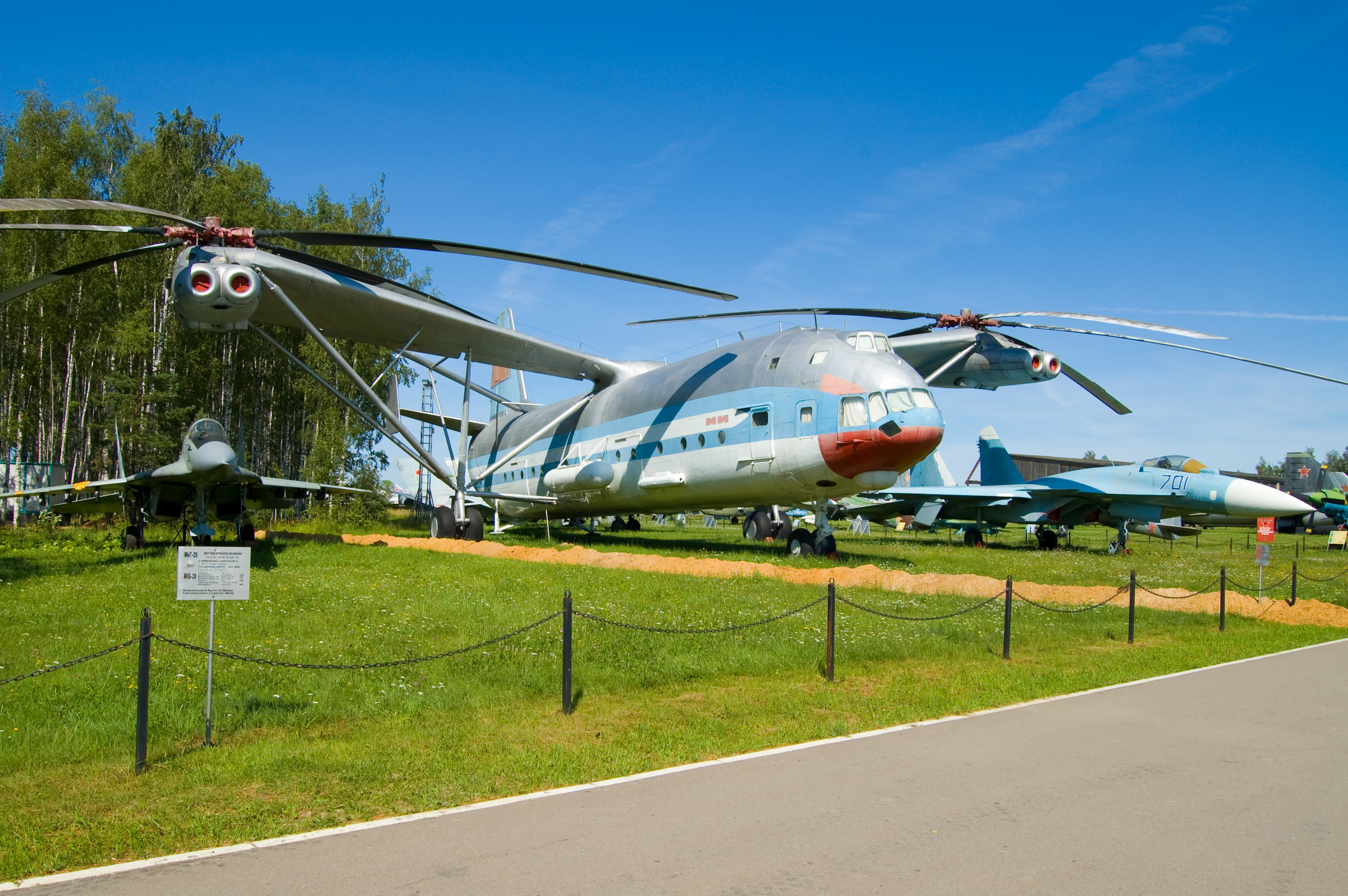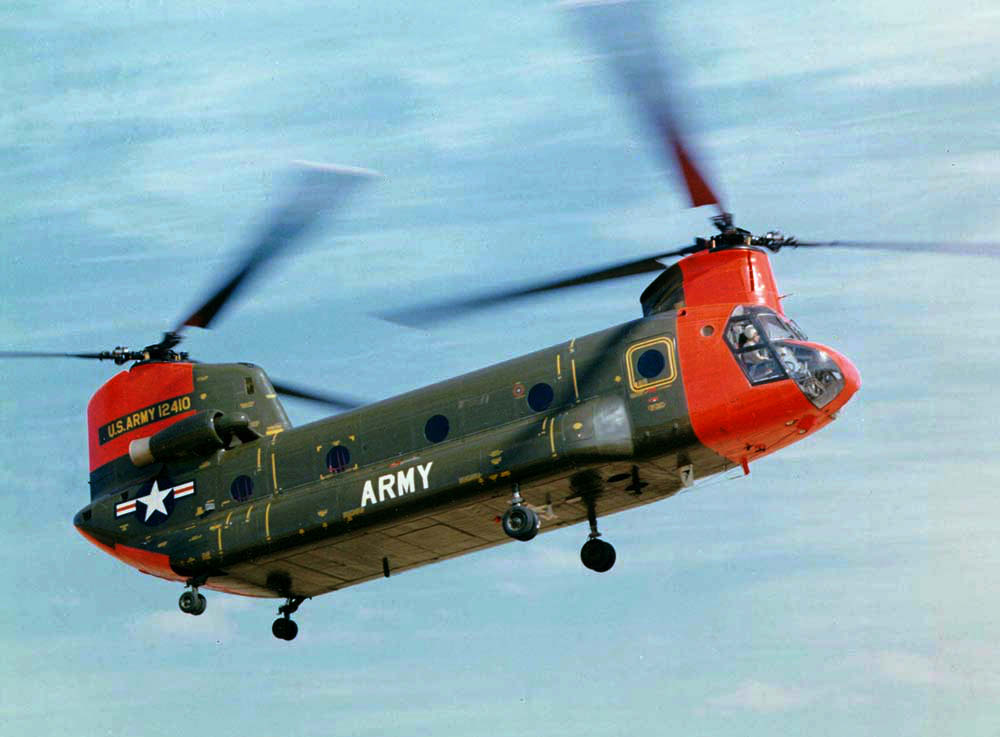|
Yakovlev Yak-60
Yakovlev Yak-60 (known as Yak-32 in some sources) is the possible designation for an experimental Yakovlev tandem-rotor heavy-lift helicopter design of the late 1960s. This design never progressed beyond the model stage. Development This helicopter was designed in the late 1960s, and may have been a competing design to the Mil Mi-12 heavy lift helicopter. It featured two Mil Mi-6 rotors in tandem, each driven by a pair of Soloviev D-25VF engines, potentially giving it four times the payload capacity of the Boeing CH-47 Chinook. The cockpit would have been similar to that of the Yakovlev Yak-24. Compared to the radical Mi-12, the Yak-60 design was far more conventional, though two Mi-12s were produced and no Yak-60s. It has been suggested that the designation Yak-60 was based on an extant study model which had the number "60" painted prominently on its side. Specifications (Yak-60 estimated) See also *Yakovlev VVP-6 *Mil V-12 References [Baidu] |
Mil Mi-12
The Mil V-12 (NATO reporting name: Homer), given the project number ''Izdeliye 65'' ("Item 65"), is the largest helicopter ever built. The designation "Mi-12" would have been the name for the production helicopter and was not applied to the V-12 prototypes. Design and development Design studies for a giant helicopter were started at the Mil OKB in 1959, receiving official sanction in 1961 by the GKAT (''Gosudarstvenny Komitet po Aviatsionnoy Tekhnike'' - State Committee on Aircraft Technology) instructing Mil to develop a helicopter capable of lifting . The GKAT directive was followed by a more detailed specification for the V-12 with hold dimensions similar to the Antonov An-22, intended to lift major items of combat materiel as well as 8K67, 8K75 and 8K82 inter-continental ballistic missiles (ICBM). Design limitations forced Mil to adopt a twin rotor system but design studies of a tandem layout, similar to the Boeing CH-47 Chinook, revealed major problems. The single rotor l ... [...More Info...] [...Related Items...] OR: [Wikipedia] [Google] [Baidu] |
Mil Mi-6
The Mil Mi-6 (NATO reporting name Hook), given the article number ''izdeliye 50'' and company designation V-6, is a Soviet/Russian heavy transport helicopter that was designed by the Mil design bureau. It was built in large numbers for both military and civil roles and used to be the largest helicopter in production until Mil Mi-26 was put in production in 1980. Design and development The Mi-6 resulted from a joint civil-military requirement for a very large vertical-lift aircraft, which could be used to add mobility in military operations as well as assist in the exploration and development of the expansive central and eastern regions of the USSR. Flown for the first time on 5 June 1957, the Mi-6 was the first Soviet turboshaft-powered production helicopter. The R-7 gearbox and rotor head developed for the project have a combined weight of 3200 kg, which is greater than the two turboshaft engines. Variable-incidence winglets were first mounted on the craft's sides in 1960 ... [...More Info...] [...Related Items...] OR: [Wikipedia] [Google] [Baidu] |
Soloviev D-25VF
The Soloviev D-25V is a Soviet gas-turbine turboshaft engine for use in large helicopters. Designed and originally manufactured by the Soloviev Design Bureau the engine has been in production since May 1960. The power unit consists of two engines coupled to a gearbox weighing 3,200 kg (7,050 lb). The ''V'' in the designation means ''vertoletny'' (russian: Вертолетный), for helicopters. Variants ;D-25V:Standard helicopter use production engines ;D-25VF:Additional compressor zero-stage, power output ;D-25VK:A combined propeller and shaft output engine for the Kamov Ka-22 developing Applications * Mi-6 helicopter * Mi-10 helicopter * Mi-10K "flying crane" helicopter * Mi-12 helicopter * Kamov Ka-22 compound helicopter * Yakovlev Yak-60 Yakovlev Yak-60 (known as Yak-32 in some sources) is the possible designation for an experimental Yakovlev tandem-rotor heavy-lift helicopter design of the late 1960s. This design never progressed beyond the model sta ... [...More Info...] [...Related Items...] OR: [Wikipedia] [Google] [Baidu] |
Boeing CH-47 Chinook
The Boeing CH-47 Chinook is a tandem rotor helicopter developed by American rotorcraft company Vertol and manufactured by Boeing Vertol. The Chinook is a heavy-lift helicopter that is among the heaviest lifting Western helicopters. Its name, Chinook, is from the Native American Chinook people of Oregon and Washington state. The Chinook was originally designed by Vertol, which had begun work in 1957 on a new tandem-rotor helicopter, designated as the Vertol Model 107 or V-107. Around the same time, the United States Department of the Army announced its intention to replace the piston engine–powered Sikorsky CH-37 Mojave with a new, gas turbine–powered helicopter. During June 1958, the U.S. Army ordered a small number of V-107s from Vertol under the ''YHC-1A'' designation; following testing, it came to be considered by some Army officials to be too heavy for the assault missions and too light for transport purposes. While the YHC-1A would be improved and adopted by the U.S. ... [...More Info...] [...Related Items...] OR: [Wikipedia] [Google] [Baidu] |
Yakovlev Yak-24
The Yakovlev Yak-24 (NATO reporting name "Horse") is a Soviet twin-engine, tandem rotor, transport helicopter developed by Yakovlev in the 1950s. The Yak-24 saw limited use in the Soviet Air Force, and the exact number produced and duration of service are unknown due to inconsistencies in data. Design and development In September 1951, following a meeting of Joseph Stalin with senior aircraft designers the Soviet Union issued two design specifications for helicopters, with the intent of rapidly accelerating Soviet helicopter development. The requirement for a medium-sized helicopter which could transport 12 people was issued to the Mil Design Bureau, which would result in the Mil Mi-4, while the requirement for a larger helicopter capable of transporting 24 people was given to the Yakovlev Design Bureau under Alexander Yakovlev. Prototypes of both types had to be flying within a year – 'unlimited support' was to be provided for these two programmes by the national research ... [...More Info...] [...Related Items...] OR: [Wikipedia] [Google] [Baidu] |
Yakovlev VVP-6
The Yakovlev VVP-6 was an experimental design for a flying support and surface-to-air missile platform, capable of vertical takeoff and landing. It never progressed beyond the model stage.Gunston, 1997 Development Perhaps the most radical design ever to emerge from the Yakovlev OKB studio, the VVP-6 appeared more science fiction than a craft likely to have seen production. The VVP-6 was designed as a giant VTOL support platform which would work in coordination with VTOL jets, such as Yakovlev's Yak-38.Gunston, 1997 Among the many functions envisioned for this line of vehicles was the transportation of food, fuel and munitions. The huge, box-like design was to have been 49m long. In one version it was capable of carrying a complete SAM missile system, including six SA-2 (ASCC name "Guideline") missiles with launchers mounted on the craft's upper surface. Reloads and supporting radars were to be stored internally.Gunston, 1997 The VVP-6 was to have been fitted with six six-blade ro ... [...More Info...] [...Related Items...] OR: [Wikipedia] [Google] [Baidu] |
Mil V-12
The Mil V-12 (NATO reporting name: Homer), given the project number ''Izdeliye 65'' ("Item 65"), is the largest helicopter ever built. The designation "Mi-12" would have been the name for the production helicopter and was not applied to the V-12 prototypes. Design and development Design studies for a giant helicopter were started at the Mil OKB in 1959, receiving official sanction in 1961 by the GKAT (''Gosudarstvenny Komitet po Aviatsionnoy Tekhnike'' - State Committee on Aircraft Technology) instructing Mil to develop a helicopter capable of lifting . The GKAT directive was followed by a more detailed specification for the V-12 with hold dimensions similar to the Antonov An-22, intended to lift major items of combat materiel as well as 8K67, 8K75 and Proton (rocket family), 8K82 inter-continental ballistic missiles (ICBM). Design limitations forced Mil to adopt a twin rotor system but design studies of a tandem layout, similar to the Boeing CH-47 Chinook, revealed major proble ... [...More Info...] [...Related Items...] OR: [Wikipedia] [Google] [Baidu] |
1960s Soviet Military Transport Aircraft
Year 196 ( CXCVI) was a leap year starting on Thursday (link will display the full calendar) of the Julian calendar. At the time, it was known as the Year of the Consulship of Dexter and Messalla (or, less frequently, year 949 ''Ab urbe condita''). The denomination 196 for this year has been used since the early medieval period, when the Anno Domini calendar era became the prevalent method in Europe for naming years. Events By place Roman Empire * Emperor Septimius Severus attempts to assassinate Clodius Albinus but fails, causing Albinus to retaliate militarily. * Emperor Septimius Severus captures and sacks Byzantium; the city is rebuilt and regains its previous prosperity. * In order to assure the support of the Roman legion in Germany on his march to Rome, Clodius Albinus is declared Augustus by his army while crossing Gaul. * Hadrian's wall in Britain is partially destroyed. China * First year of the '' Jian'an era of the Chinese Han Dynasty. * Emperor Xian of ... [...More Info...] [...Related Items...] OR: [Wikipedia] [Google] [Baidu] |
Yakovlev Aircraft
The JSC A.S. Yakovlev Design Bureau (russian: ОАО Опытно-конструкторское бюро им. А.С. Яковлева) is a Russian aircraft designer and manufacturer (design office prefix Yak). Its head office is in Aeroport District, Northern Administrative Okrug, Moscow. Overview The bureau formed in 1934 under designer Alexander Sergeyevich Yakovlev as OKB-115 (the design bureau has its own production base at the facility No.115), but dates its birth from 12 May 1927, the day of maiden flight of the AIR-1 aircraft developed within the Department of Light Aircraft of GUAP (Head Agency of Aviation Industry) under the supervision of A.S. Yakovlev. During World War II Yakovlev designed and produced a famed line of fighter aircraft. Irkut acquired Yakovlev in April 2004. [...More Info...] [...Related Items...] OR: [Wikipedia] [Google] [Baidu] |
Military Helicopters
A military helicopter is a helicopter that is either specifically built or converted for use by military forces. A military helicopter's mission is a function of its design or conversion. The most common use of military helicopters is transport of troops, but transport helicopters can be modified or converted to perform other missions such as combat search and rescue (CSAR), medical evacuation (MEDEVAC), airborne command post, or even armed with weapons for attacking ground targets. Specialized military helicopters are intended to conduct specific missions. Examples of specialized military helicopters are attack helicopters, observation helicopters and anti-submarine warfare helicopters. Types and roles Military helicopters play an integral part in the sea, land and air operations of modern militaries. Generally manufacturers will develop airframes in different weight/size classes which can be adapted to different roles through the installation of mission specific equipment. To ... [...More Info...] [...Related Items...] OR: [Wikipedia] [Google] [Baidu] |
Abandoned Military Aircraft Projects Of The Soviet Union
Abandon, abandoned, or abandonment may refer to: Common uses * Abandonment (emotional), a subjective emotional state in which people feel undesired, left behind, insecure, or discarded * Abandonment (legal), a legal term regarding property ** Child abandonment, the extralegal abandonment of children ** Lost, mislaid, and abandoned property, legal status of property after abandonment and rediscovery * Abandonment (mysticism) Art, entertainment, and media Film * ''Abandon'' (film), a 2002 film starring Katie Holmes * ''Abandoned'' (1949 film), starring Dennis O'Keefe * ''Abandoned'' (1955 film), the English language title of the Italian war film ''Gli Sbandati'' * ''Abandoned'' (2001 film), a Hungarian film * ''Abandoned'' (2010 film), starring Brittany Murphy * ''Abandoned'' (2015 film), a television movie about the shipwreck of the ''Rose-Noëlle'' in 1989 * ''Abandoned'' (2022 film), starring Emma Roberts * ''The Abandoned'' (1945 film), a 1945 Mexican film * ''The Aba ... [...More Info...] [...Related Items...] OR: [Wikipedia] [Google] [Baidu] |



.jpg)
